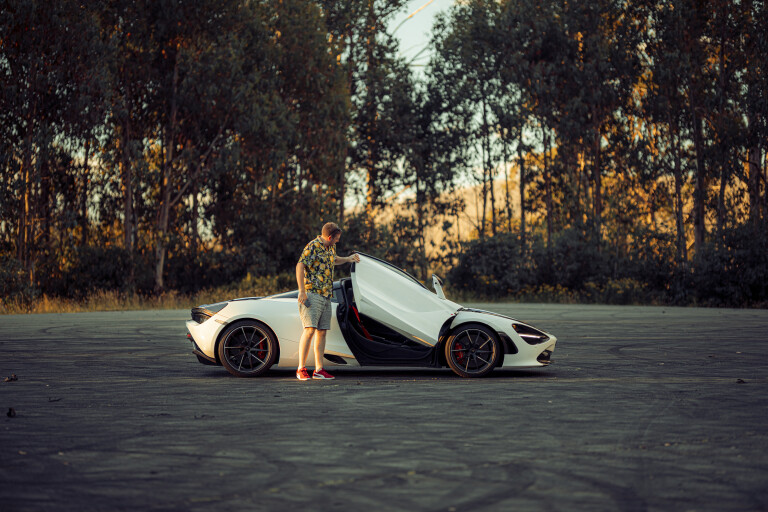
Introduction: Big Mac with The Lot
Our long-term fleet gains the doors of a billionaire... and 530kW
Say hello to the most thrilling long termer in MOTOR history – the McLaren 720S. Woking’s Super Series darling has joined our fleet of cars, but don’t think we’ll be giving the supercar kiddie-glove treatment. We intend to treat the 530kW/770Nm, half-million dollar beast like we would any other long-termer. Big drives, daily use, spirited excursions, it’s all part of the remit.
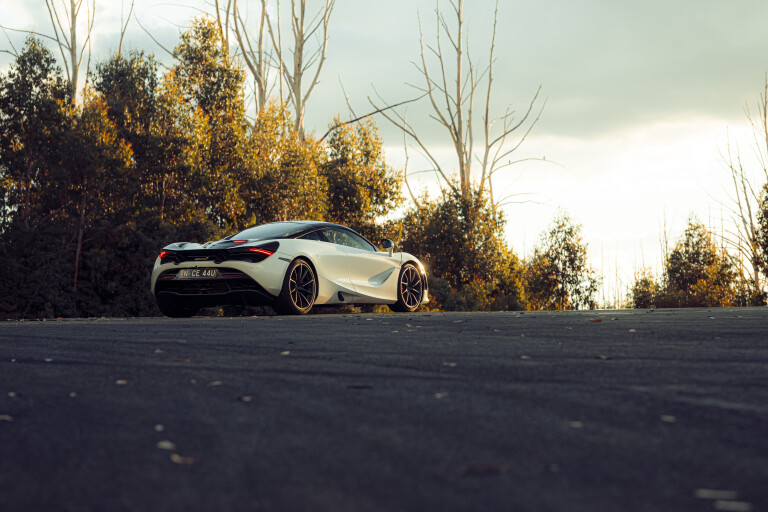
The 720S sits in an interesting place in McLaren’s line-up. It is, and will remain for the time being, the most powerful series production car you can buy from the British brand. Limited-run specials like the Longtails, Senna and Speedtail will sit above it, while the electrified V6 Artura will sit ever so slightly below when it finally arrives. Other than the grand touring GT, that’s it for McLaren’s rationalised line-up.
First revealed in 2017 the supercar game has moved on significantly since the 720S first peeked its sunken eye sockets beyond the curtain at the Geneva Motor Show. Can it stack up against its more modern supercar rivals in 2022?
It certainly fills the brief in terms of monetary exclusivity. McLaren are more than happy to tell us exactly what options are fitted to our test car – but remain strangely coy about the exact price of fitting them to the car. Our best guide is that the dealer box-ticking would come in around $200,000. That’s on top of the $489,900 sticker and on-roads. Though, if you must ask what the cost of the options are, it’s fair to say they don’t fall within your budget.
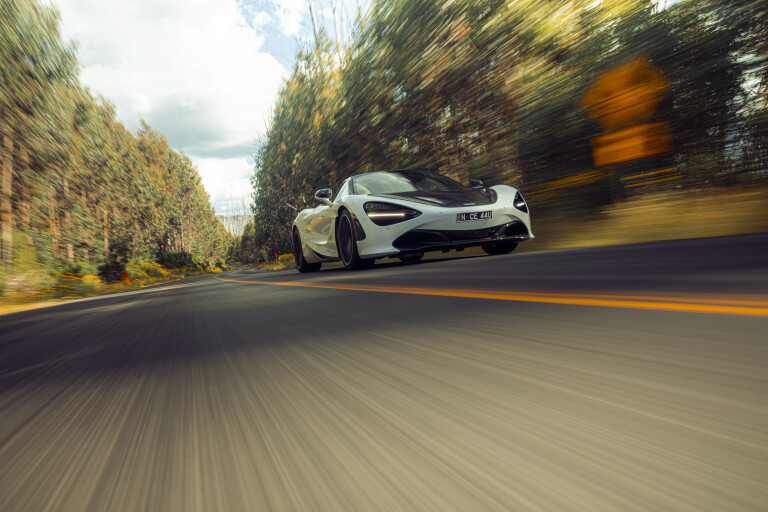
For the curious, ‘our’ McLaren comes fitted with the Performance Plus Pack, nine separate exterior carbon-fibre items (which will set you back roughly $100,000 alone), sports exhaust, soft close doors, diamond cut wheels, carbon-ceramic brakes, tyre pressure monitoring system, 360-degree parking camera, front nose lift, and a printed owner’s manual.
I share this in the name of transparency, but it’d be reductionist to focus on the deep fiduciary well that is McLaren Special Operations extras that are nice-to-haves on top of the 720S stunning core ability.
Of the options fitted, it’s only the nose lift that we’d recommend be a mandatory addition. There’s substantial front overhang on the 720S and without it most urban driveways would be inaccessible unless you wanted finely grated carbon fibre left on the street. My nerves barely survived a tour of an underground carpark underneath my local grocer.

Despite all the pretence and potency contained beneath its skin, the 720S is remarkably approachable day-to-day if you avoid tight parking caverns. You sit quite far forward, giving you the sensation of being strapped into the front cabin of an alien spaceship. We aren’t going to lie to you and claim the interior of the 720S is spacious, but McLaren has been clever with the space that is available.
There are two useable cup holders, a tray for your phone, wallet, and keys (that can contain these items even under heavy acceleration loads), an appropriately sized centre console, two additional hidden compartments in the doors, and a fairly large parcel shelf behind the seats. That’s not including the surprisingly deep front luggage area totalling 150 litres – or to give some real-world context, enough space for two people’s carry-on luggage. Nice, but a GT this is not. McLaren still offers the imaginatively named GT for those wanting touring ability.
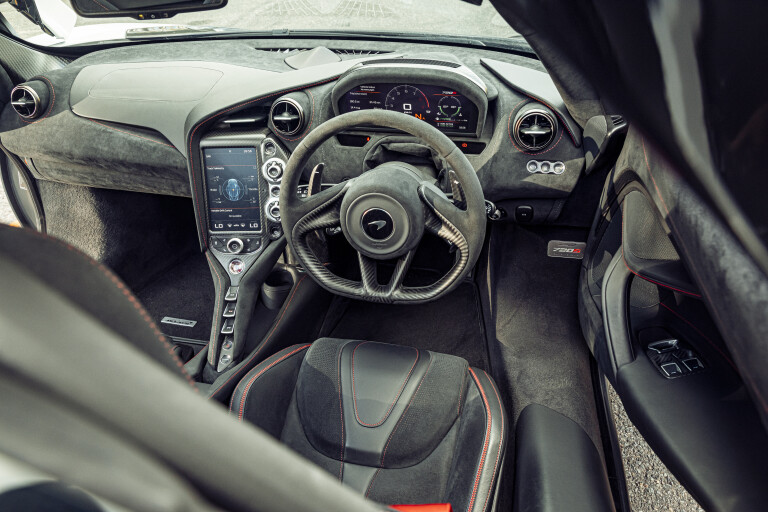
The biggest quirk-turned-gripe that has appeared on the daily commute is pedal placement, which caters heavily to left-foot braking on track. My size 11 feet mean that with certain shoes when I have my left foot placed on the rest plate to the far side of the footwell I can only have part of my right foot on the brake pedal. To get proper coverage of the brake I need to pull my left foot back to me and place it flat on the floor to allow enough space for my right foot. Adapt to a two-foot driving style and this issue withers away.
So far the most surprising element to the 720S has been just how damn well it rides. The hydraulically interlinked dampers allow McLaren to design the car without anti-roll bars, meaning each wheel deals with bumps and imperfections entirely independently. A drive in Affat’s Kona N drove home exactly how well judged the ride quality of the McLaren is – this is a high-end supercar with mind-warping levels of performance and body control that’d make Porsche engineers intrigued, while still riding better than some family-focused SUVs. Though to get the best out of the system you need to activate it by pressing a centre console-mounted button. Without doing so feels like the car is riding on house bricks instead of actual springs.
That is just one small part of the slightly lengthy start up process for the McLaren. It goes something like this. Foot on brake, press start, wait for engine to properly fire, activate suspension and powertrain modes, raise nose for driveway, select drive, release handbrake, and then you are good to roll. You feel like an astronaut completing pre-flight checks as you flick switches spread around the cabin, waiting for the appropriate chimes and dings to confirm that everything is cleared for launch.
When you do hit the open road, the McLaren provides you with a comprehensive rewiring of what you thought possible. Even initial interactions with the 4.0-litre twin-turbo flat-plane crank V8 – codename M840T – is enough to make you abundantly aware of the unit’s tarmac-ripping potential. Even in its tamest settings, throttle response and progression is sharp, the car happy to leap forward on your command. Press toward the firewall, and you need to have your wits about you – 530kW and 770Nm is fed through an open differential to the rear wheels exclusively.

Under heavy acceleration, the 720S will squirm and shake at the rear before transposing everything ahead of you much, much closer at a rapid rate. Stay tuned next month for a deeper dynamic inspection, but already the price you pay for all that power is abundantly clear. The M840T doesn’t so much drink fuel as chug it, just peep our fuel figures as proof.
Genuine and nuanced impressions of the McLaren’s nature can be hard to parse from its outrageous extremes. The 720S is a case study in shock and awe. From its visual presence to its power delivery, Woking’s creation asserts its dominance with an overwhelming sensory overload. Weather the initial barrage though, and the intricate layers of complexity begin to be revealed.
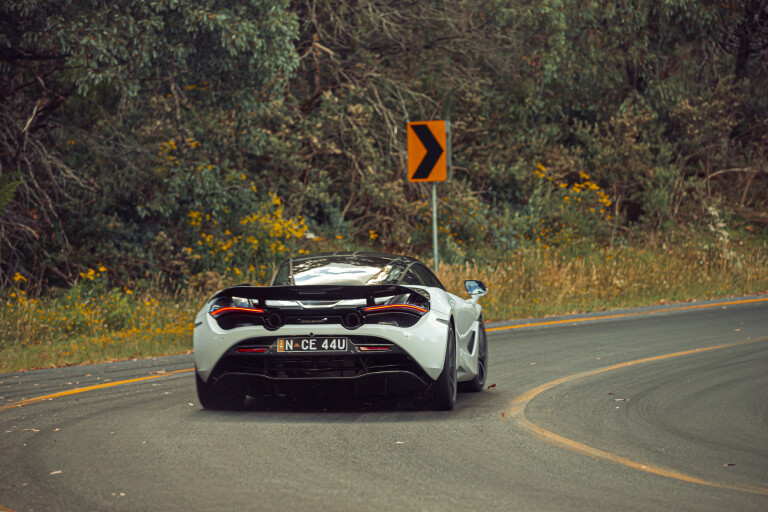
Criticism of the 720S that claim it to be characterless are muddied and short sighted. It’s early days, but the 720S is as defining of the supercar genre in 2022 as it was when it arrived five years ago. In our next instalment the leash is removed and the 720S is given room to truly stretch its legs. – CK
Things we love:
- Compliant ride
- X Factor
- It's 'ours'
Things we rue:
- Heavy fuel use
- Pedal placement
- Front overhang
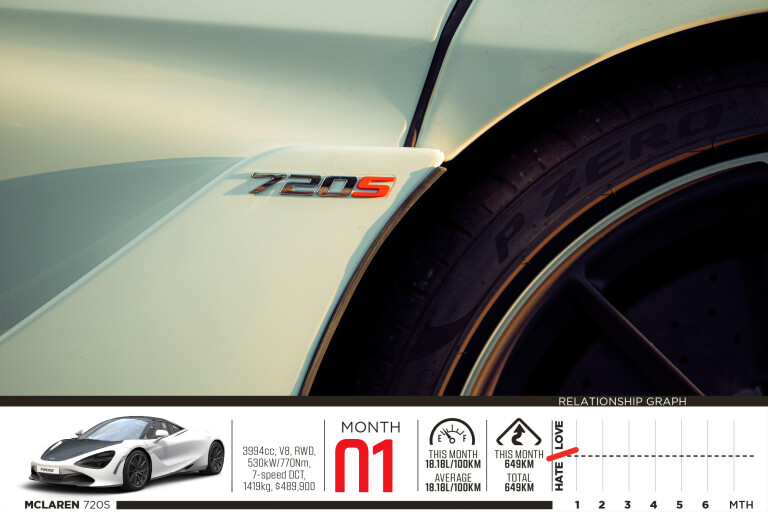
Month Two: Spoiler Warning
You didn't think we'd book Phillip Island and not bring the 720S, did you?
By all accounts I should have been ready to pull up stumps. It was day four of this year’s bumper Performance Car of the Year testing, and I’d just spent the last seven hours putting our entire 18 car field through their paces at Phillip Island Grand Prix Circuit.
Track testing that many vehicles is a mammoth task in its own right, but adding in intermittent rain showers, suicidal Cape Barren geese, and the mental workout of keeping on top of the logistics required to keep the show running smoothly meant I was one missed caffeine injection from becoming a standing corpse.
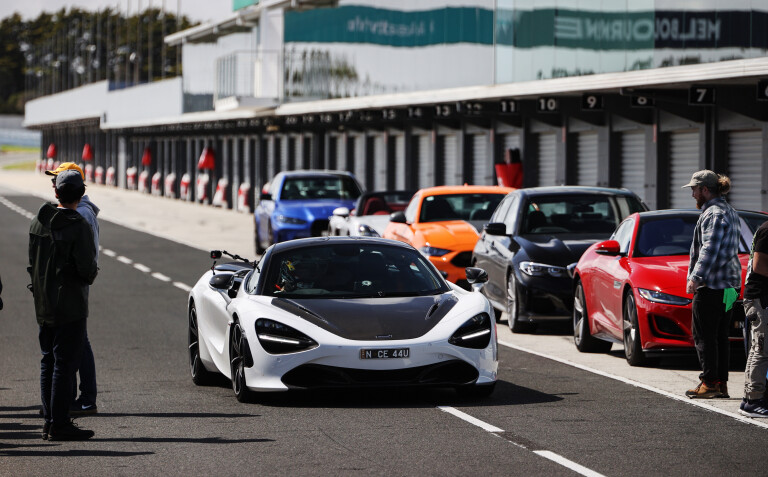
The rest of the judging panel had removed their helmets for the last time, but my work wasn’t done yet. Car number 19 for the day demanded its pound of flesh, and I was more than willing to provide. It wasn’t a contender for either of this year’s awards, but ‘our’ McLaren 720S long term tester. Things were about to get very, very fast.
While no longer a possible entrant for Australia’s premier performance car award, we weren’t going to let an opportunity to have the 720S tag along for the final days of testing slide.
If Phillip Island was a daunting plank above the ocean for our PCOTY and SCOTY contenders, the 720S was the golden-toothed pirate telling them to start walking. Not so much a wildcard, but a 530kW measuring stick that we promptly used to beat the field into submission with.
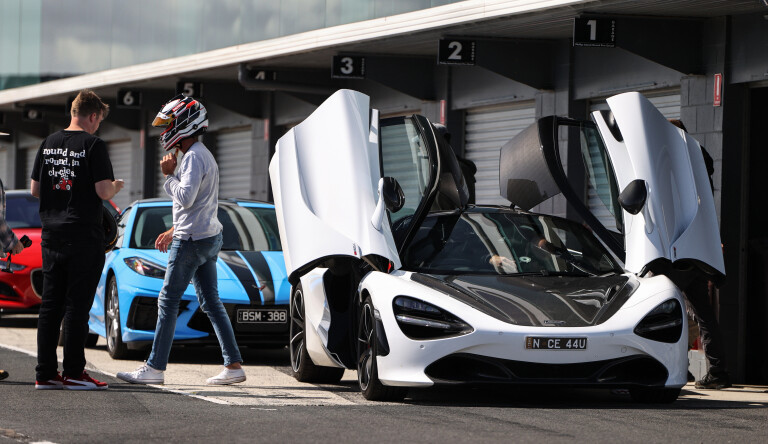
Before I wrap my hands around the svelte Alcantara-clad steering wheel, the indomitable Warren Luff slides over the carbon sills and we strap timing gear to the windscreen. Of the 18 car combined PCOTY and SCOTY contenders, only one was quicker than the 720S around Phillip Island. No prizes for correctly guessing it would be the Porsche 911 GT3.
Less than a second separate the two, with Luff’s best time in the McLaren being a 1:40.19, compared to his PCOTY-leading 1:39.74 benchmark set at the helm of the GT3. However, unlike the Porsche, which focuses heavily on track ability, the 720S is a road car first and foremost. An incredibly dramatic, powerful, and capable road car, yes, but we wouldn’t call it a track toy by any stretch.
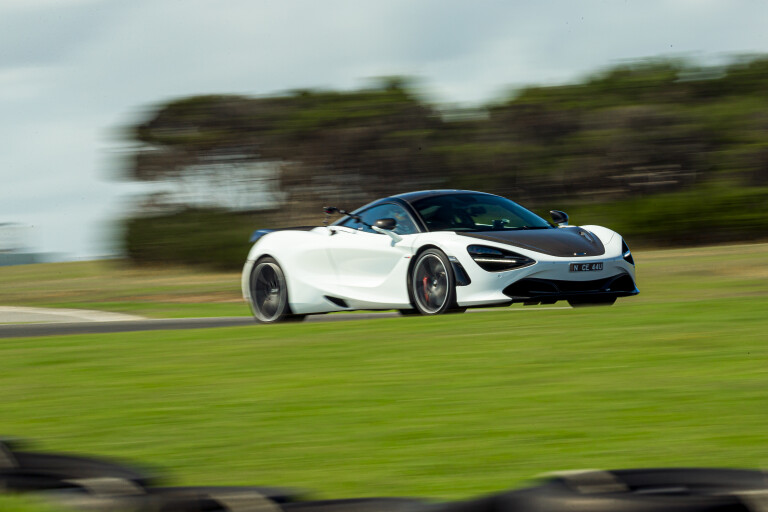
The more natural rival for the 720S at PCOTY was the $498,665, 470kW/600Nm 5.2-litre naturally aspirated V10-powered Lamborghini Huracán Fluo Capsule.
The Italian costs just $8765 more (practically pocket change in the half-million dollar price bracket), is down 60kW and 170Nm compared to the heavily turbocharged V8 McLaren, but uses an extra pair of driven wheels. Both the Huracán and 720S came equipped with Pirelli P Zero tyres that, frankly, aren’t up to the task of providing adequate grip for the amount of speed these vehicles can pile on in short order.
There is nowhere to hide for the Huracán, which is just a tenth shy of being three full seconds behind the 720S over a 4.4km lap. There’s no amount of excess Staedtler highlighter paint that’ll cover that gap.

Watching Luff’s flying laps is an experience akin to seeing a low-flying fighter jet buzz a tower. You see the McLaren before you hear it, but the once-distant speck of white is suddenly atop you with a delayed burst of sound that is much a mix of air displacement as it is angry combustion.
Approaching a 278km/h V-max at the end of the front straight, it sounds like the air itself is being torn asunder as the 720S passes. There are no theatrics-by-design, with the shock factor coming from raw presence and speed alone.
Warren Luff is not a man easily challenged by modern road cars, but the wide-eyed stare upon returning to the pits was telling of the 720S capabilities. More so was his claim that this is the first road car he’s driven that has the same cut-throat personality of a racing car. Get it wrong and it’ll bite. I think of this as I remember the fact that there are no small accidents at a circuit as fast as Phillip Island.
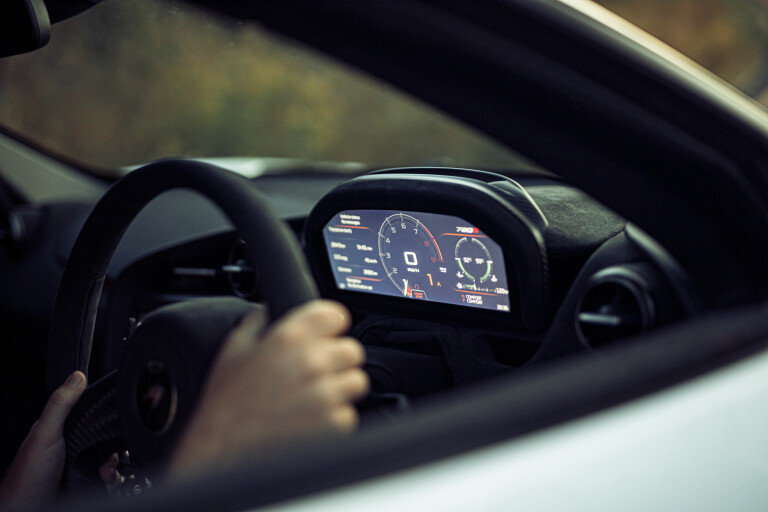
Excitement masks anxiety as I belt on the brain bucket tighter than I have all day. My turn.
Instead of disaster, I experience an adrenaline high that I’m yet to come down from.
Such is the level of the 720S’ firepower that it often struggles to deploy it appropriately. At the exit of the last turn on my first flying lap I thought something had gone awry with the car. I was applying throttle progressively but it felt like the engine wasn’t building boost. A traction control light that was fixed alight from apex all the way down the first third of the straight singled out traction as the true culprit.
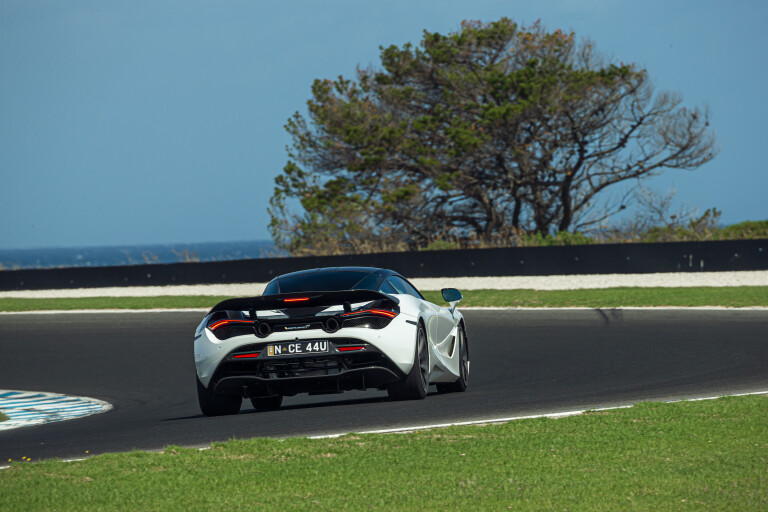
Patience is a virtue in the 720S, as I had to wait longer to get on the throttle than any other car on the day, and apply it deftly to avoid unwanted wheelspin – which you’ll still encounter with all systems on.
A cheeky look at the speedo confirmed I was exiting the last corner slower than I did in either the GT3 or Huracán, but had a nearly 10km/h advantage come the braking zone for Turn 1.
The greatest criticism that can be levelled at the 720S on track is focused entirely on the front tyres. McLaren’s choice of 245-section rubber for the front end leaves the 720S short-changed. Through the seriously fast corners, where you need confidence in the front axle the most, I was left wanting.

Thankfully steering feel and feedback is superb. Being a hydraulic steering system, every texture of the circuit’s surface was transposed directly into my fingertips, making me consistently aware of the waning grip levels mid-corner.
Still, the early signs of understeer aren’t something you want to encounter at 200km/h. A more aggressive Corsa compound is available as a no-cost option. Take it. You won’t be making a meaningful sacrifice in daily noise and gaining a significant performance benefit in return.
The 720S is a car that challenges you instead of coddling. It demands your respect, and talent. But that’s the point. This isn’t a supercar you can get into, half-arse, and still go quickly.

Given the opportunity to spend an entire day on Australia’s fastest permanent circuit with Luffy’s tutelage and the choice between a GT3 and 720S it’d be another tally in the win column for England for me.
Yes, even in the hands of a professional it’s not as quick as the Porsche, and when both are road registered the McLaren would command almost double the price. But there’s more to learn from its bristles, a skill to develop at every corner.
The 720S provides a driving test with ever-present consequences, demanding an elevation of your skills. Many will prefer the Huracán’s styling and soundtrack, but there’s something about the 720S, and its permanent spectre of consequence, that’s simultaneously scary yet hard to resist.
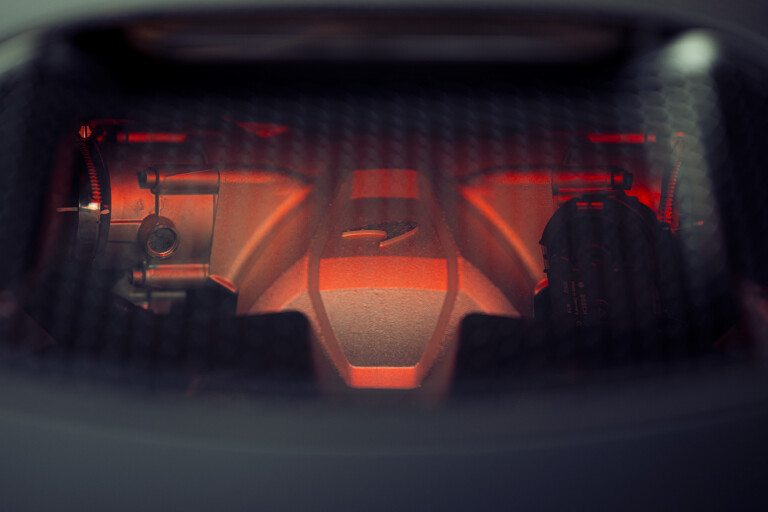
Modern supercars are derided for being too friendly, protecting ham-fisted pilots with a thick electronic support network of systems designed to flatter egos.
On the track, Woking’s wonder is not that kind of supercar. Cars & Coffee posers need not apply. – CK
Things we love:
- Track time
- Steering feel
- Headroom
Things we rue:
- Tyre compound
- Tyre footprint
- Passing of time




COMMENTS